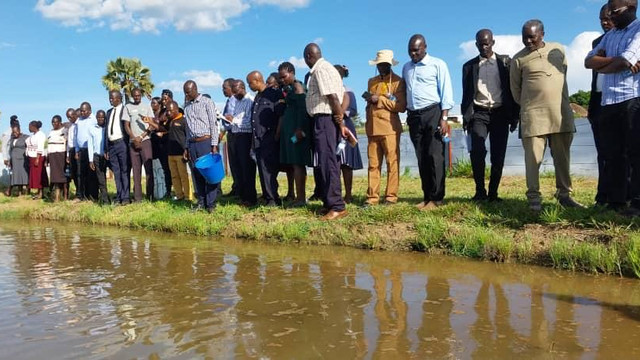Working with nature to manage water resources in a changing climate
Experiences from South Africa and Uganda highlight how incorporating a watershed approach into the design and implementation of ecosystem-based adaptation activities can help us preserve one of our most treasured resources in a changing climate.



A restored spring in Mabheleni village, South Africa. The water is captured from the eye of the spring into a settling tank allowing clear water to run through the pipes to the reservoir, which allows easier collection of water by community members (Photo: C Rose/Conservation South Africa)
Climate change is wreaking havoc on our water cycle, leading to unpredictable water availability and exacerbating water scarcity. Meanwhile, record numbers of water-related related disasters – droughts, floods and storms – are destroying the lives of millions.
Healthy, diverse ecosystems can help people adapt to, or better manage, these changes. By conserving, restoring and sustainably managing ecosystems, ecosystem-based adaptation (EbA) can reverse ecosystem degradation and help make societies more resilient to climate impacts. Better-protected wetlands, for example, can help purify water and control floods.
Conserving or restoring forests or grasslands can slow run-off, increase soil water and recharge groundwater resources while looking after upstream ecosystems can help preserve water supplies in downstream areas.
To mark World Water Day on 22 March, IIED has published a photo story showcasing how ecosystem-based watershed approaches in South Africa and Uganda are helping people adapt to these climate change impacts.
Why take a watershed approach?
A watershed is any area of land that channels rainfall and snowmelt to creeks, streams and rivers and eventually flows into reservoirs, bays and the ocean.
Ecosystem-based watershed approaches allow people to envision and manage the complex links between land, water and human activities.
For example, in the large montane forest ecosystems near Uganda’s Mount Elgon’s peak a watershed approach has allowed natural resource managers to understand how deforestation, unsustainable agriculture practices and erosion of riverbanks affect water quality and exacerbate floods, landslides and droughts.
In addition, as a shared resource, water can be a common entry point – and watershed approaches can bring together different stakeholders – government, communities, NGOs, water users, media, researchers and the private sector – from across diverse sectors that may not otherwise work together.
An integrated multi-stakeholder approach is crucial for ensuring a healthy ecosystem that underpins our ability to adapt to climate change.
Working across different scales
Experiences from South Africa and Uganda highlight the importance of working and coordinating activities across local, sub-national and national scales to ensure effective ecosystem-based watershed approaches for climate change adaptation. Stakeholders working at these different levels all play important and complementary roles.
Uganda’s national government formulates policies and legislation and develops guidelines to support stakeholders to devise and implement their own watershed plans.
To facilitate sustainable management of Uganda’s water resources, the government adopts a decentralized management structure and delineates the country into four hydrological management units called water management zones (WMZ).
Following national guidelines, each WMZ plans, manages and coordinates activities to manage water resources within the zone. WMZ establish and facilitate multi-stakeholder platforms that bring different stakeholders together to develop catchment management plans.
These plans include priority investment options – such as where best to invest resources for watershed management – and ecosystem restoration activities that are implemented as set out in the plans.

Community planning meeting in Sanzara parish, Kapchorwa district in Eastern Uganda (Photo: copyright IUCN Uganda)
Tackling complexity and building consensus through partnerships
But working across different scales can be challenging. It requires understanding the complex interrelationships between land and water, highland and lowland, urban and rural. It also requires fostering trust and partnerships among diverse stakeholders across different sectors.
The experiences from Umzimvubu Catchment Partnership (UCP) in South Africa shows how multi-stakeholder partnerships can help navigate such complexity and build consensus among different groups.
UCP brought together representatives from civil society, NGOs, academics, local, district and national governments, the private sector and community groups who together formulated a 20-year vision to conserve and sustainably manage water and natural resources over a 435,000 ha watershed and helped people living in the area adapt to climate change.
In a further example, groups from across the Matatiele Local Municipality worked together to generate a comprehensive geographic information system database including information on invasive plant infestations. Invasive plants can reduce water availability – so controlling those invasive plants helped reduce water stresses caused by climate change.
UCP provides a platform for diverse stakeholders to leverage their complementary skills and expertise to tackle the complexity of working in a large watershed. Their combined efforts support local communities by restoring grassland, wetland and rivers, and help rebuild natural vegetation in the watershed’s rangeland area.
This vegetation not only improved the soil’s water retention but helped purify local water sources. People living in and around the watershed now benefit from improved water quality and secure access to water despite the region’s increasingly unpredictable rainfall patterns.
On World Water Day, these inspiring stories from South Africa and Uganda remind us of the importance of working with nature to cope with climate change impacts and preserve one of our most treasured natural resources: water.
By working collaboratively across different scales and sectors, we can achieve transformative change that will benefit nature, people and help us adapt to a changing climate.
- Find out more about the experiences in South Africa and Uganda in this storymap.
- If you are interested in EbA approaches in watersheds, find tools for planning, developing proposals and more in our EbA Tools Navigator.




